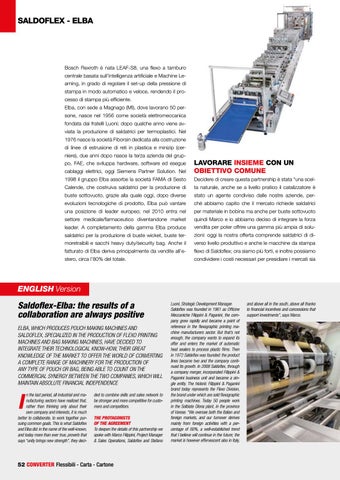SALDOFLEX - ELBA
Bosch Rexroth è nata LEAF-S8, una flexo a tamburo centrale basata sull’intelligenza artificiale e Machine Learning, in grado di regolare il set-up della pressione di stampa in modo automatico e veloce, rendendo il processo di stampa più efficiente. Elba, con sede a Magnago (MI), dove lavorano 50 persone, nasce nel 1956 come società elettromeccanica fondata dai fratelli Luoni; dopo qualche anno viene avviata la produzione di saldatrici per termoplastici. Nel 1976 nasce la società Fiborsin dedicata alla costruzione di linee di estrusione di reti in plastica e minizip (cerniere), due anni dopo nasce la terza azienda del grupcablaggi elettrici, oggi Siemens Partner Solution. Nel
LAVORARE INSIEME CON UN OBIETTIVO COMUNE
1998 il gruppo Elba assorbe la società FAMA di Sesto
Decidere di creare questa partnership è stata “una scel-
Calende, che costruiva saldatrici per la produzione di
ta naturale, anche se a livello pratico il catalizzatore è
buste sottovuoto, grazie alla quale oggi, dopo diverse
stato un agente condiviso dalle nostre aziende, per-
evoluzioni tecnologiche di prodotto, Elba può vantare
ché abbiamo capito che il mercato richiede saldatrici
una posizione di leader europeo; nel 2010 entra nel
per materiale in bobina ma anche per buste sottovuoto
settore medicale/farmaceutico diventandone market
quindi Marco e io abbiamo deciso di integrare la forza
leader. A completamento della gamma Elba produce
vendita per poter offrire una gamma più ampia di solu-
saldatrici per la produzione di buste wicket, buste ter-
zioni: oggi la nostra offerta comprende saldatrici di di-
moretraibili e sacchi heavy duty/security bag. Anche il
verso livello produttivo e anche le macchine da stampa
fatturato di Elba deriva principalmente da vendite all’e-
flexo di Saldoflex; ora siamo più forti, e inoltre possiamo
stero, circa l’80% del totale.
condividere i costi necessari per presidiare i mercati sia
po, FAE, che sviluppa hardware, software ed esegue
ENGLISH Version
Saldoflex-Elba: the results of a collaboration are always positive ELBA, WHICH PRODUCES POUCH MAKING MACHINES AND SALDOFLEX, SPECIALIZED IN THE PRODUCTION OF FLEXO PRINTING MACHINES AND BAG MAKING MACHINES, HAVE DECIDED TO INTEGRATE THEIR TECHNOLOGICAL KNOW-HOW, THEIR GREAT KNOWLEDGE OF THE MARKET TO OFFER THE WORLD OF CONVERTING A COMPLETE RANGE OF MACHINERY FOR THE PRODUCTION OF ANY TYPE OF POUCH OR BAG, BEING ABLE TO COUNT ON THE COMMERCIAL SYNERGY BETWEEN THE TWO COMPANIES, WHICH WILL MAINTAIN ABSOLUTE FINANCIAL INDEPENDENCE
I
n the last period, all industrial and manufacturing sectors have realized that, rather than thinking only about their own company and interests, it is much better to collaborate, to work together pursuing common goals. This is what Saldoflex and Elba did: in the name of the well-known, and today more than ever true, proverb that says “unity brings new strength”, they deci-
ded to combine skills and sales network to be stronger and more competitive for customers and competitors. THE PROTAGONISTS OF THE AGREEMENT To deepen the details of this partnership we spoke with Marco Filippini, Project Manager & Sales Operations, Saldoflex and Stefano
52 CONVERTER Flessibili - Carta - Cartone
Luoni, Strategic Development Manager. Saldoflex was founded in 1961 as Officine Meccaniche Filippini & Paganini, the company grew rapidly and became a point of reference in the flexographic printing machine manufacturers sector. But that’s not enough, the company wants to expand its offer and enters the market of automatic heat sealers to process plastic films. Then in 1972 Saldoflex was founded: the product lines became two and the company continued its growth. In 2008 Saldoflex, through a company merger, incorporated Filippini & Paganini business unit and became a single entity. The historic Filippini & Paganini brand today represents the Flexo Division, the brand under which are sold flexographic printing machines. Today 50 people work in the Solbiate Olona plant, in the province of Varese. “We oversee both the Italian and foreign markets, and our turnover derives mainly from foreign activities with a percentage of 60%, a well-established trend that I believe will continue in the future; the market is however effervescent also in Italy,
and above all in the south, above all thanks to financial incentives and concessions that support investments”, says Marco.






















